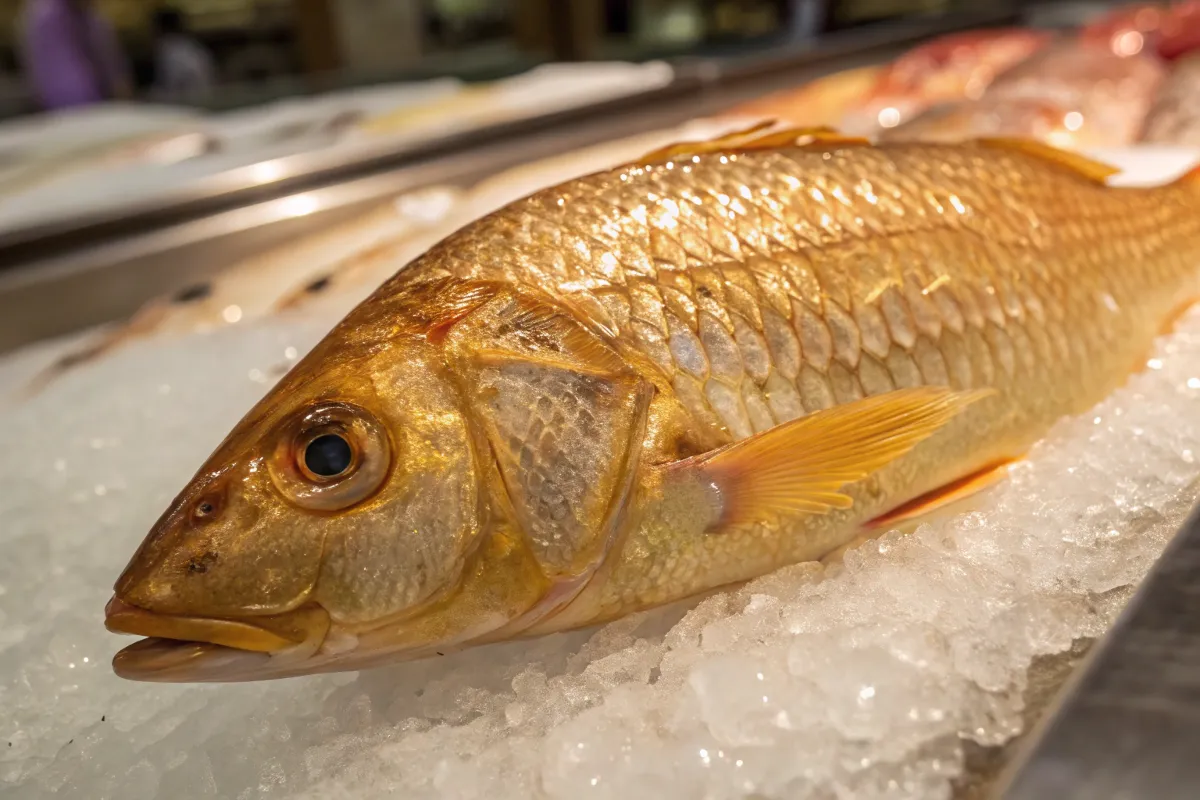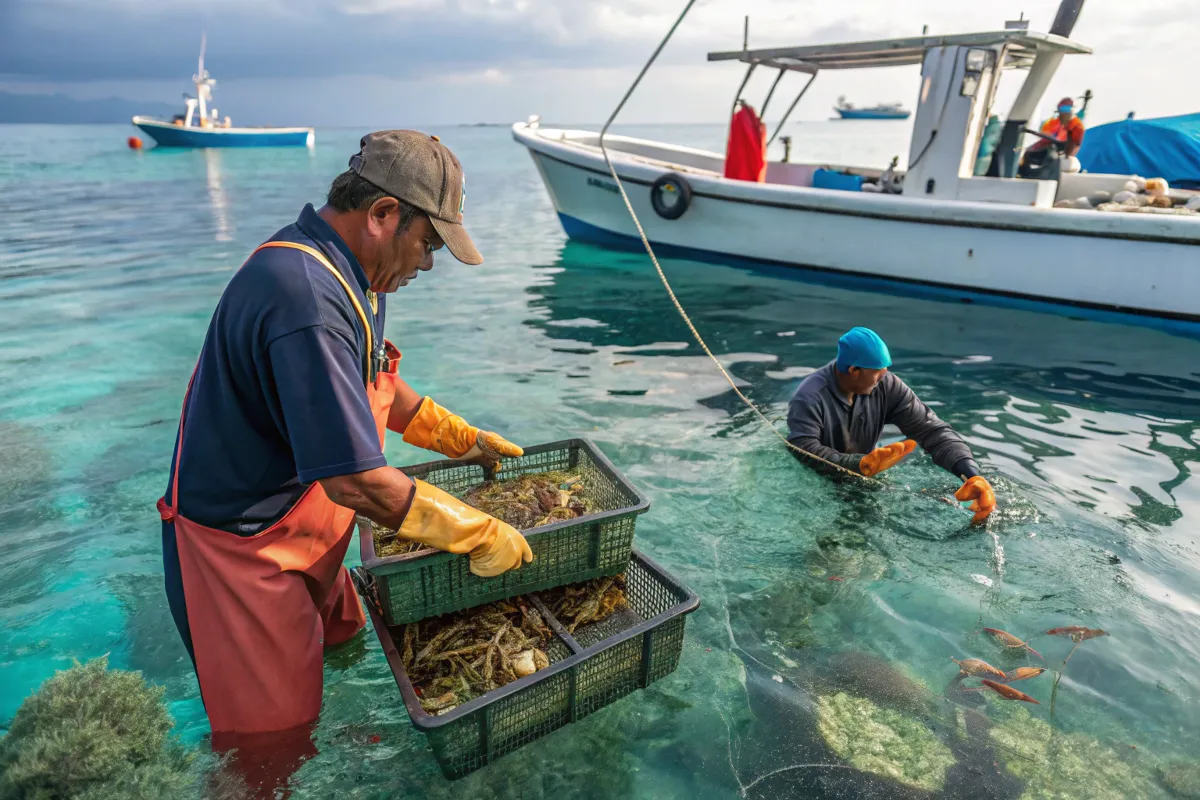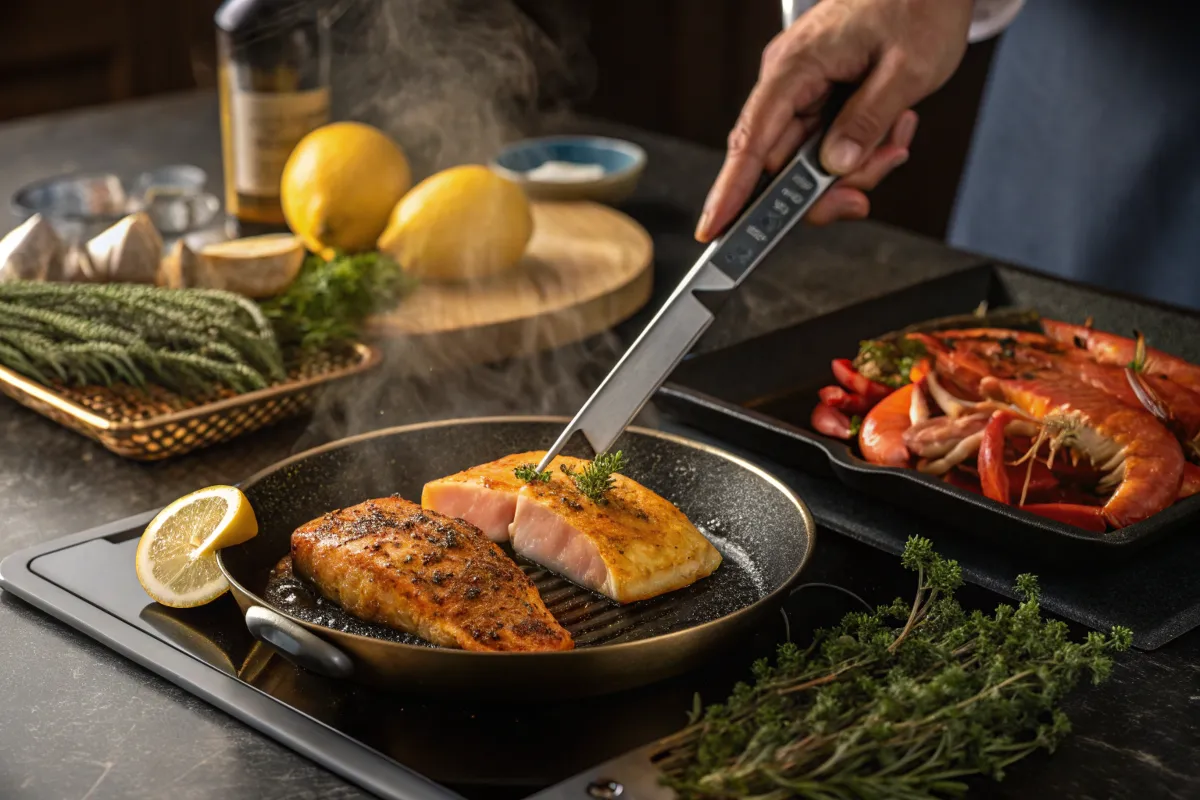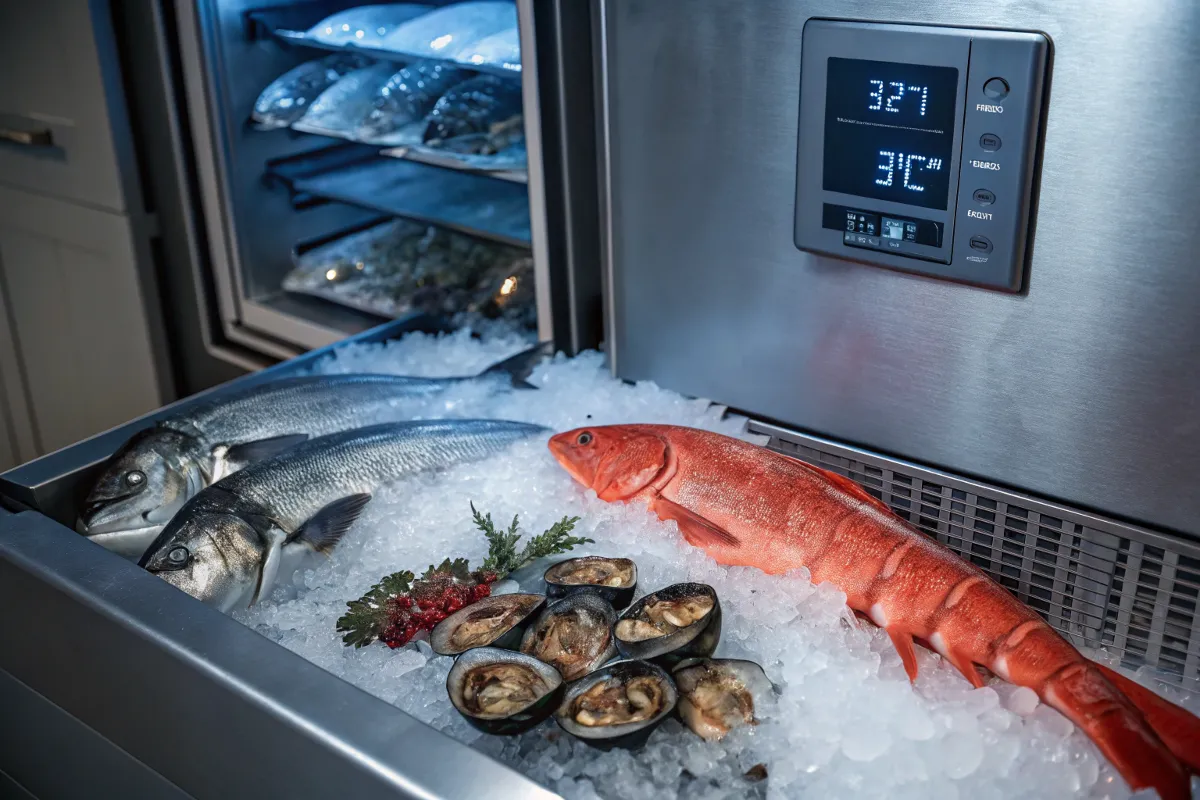I love seafood and the fresh flavors it brings. Thinking about golden seafood makes me feel happy. This guide will take you on a journey through the best of ocean cuisine. Every bite will make your taste buds dance with joy.
Seafood is amazing because it’s versatile, nutritious, and can be made into art. But not all seafood is the same. Golden seafood takes it to a new level, offering unmatched quality and taste. It will change how you see seafood forever.
Key Takeaways
- Discover the fascinating origins of luxury seafood cuisine and what defines “golden” quality
- Explore the essential fresh fish selection tips that will elevate your home cooking
- Uncover the characteristics of premium shellfish varieties, from premium oysters to rare and exotic options
- Understand the importance of sustainable practices in premium seafood sourcing
- Dive into the world of artisanal fishing methods and their impact on seafood quality
Understanding Golden Seafood: A Premium Dining Experience

Dive into the world of golden seafood. Here, the best ocean delicacies come together for a culinary masterpiece. We look into the rich history and high standards that make seafood “golden” quality.
The Origins of Luxury Seafood Cuisine
The charm of golden seafood goes back to ancient times. It was a sign of wealth and taste in ancient China and Greece. These cultures sought rare and exquisite seafood delicacies for their feasts.
What Makes Seafood “Golden” Quality
“Golden” in golden seafood means top-notch quality and rarity. These premium shellfish and finfish are chosen for their size, texture, flavor, and looks. Only the best are called “golden”.
Quality Indicators in Premium Seafood
- Vibrant, glistening appearance
- Firm, resilient texture
- Subtle, refined aromas and flavors
- Carefully sourced from sustainable fisheries
Knowing these signs of excellence helps you spot true golden seafood. It makes your dining experience special and raises your taste to new levels.
Essential Fresh Fish Selection Tips for Home Chefs
Choosing the freshest and most sustainable fresh fish is key for tasty seafood dishes. Whether you’re at the local market or online, consider a few important factors. These will help you pick the best catch of the day.
First, look at the fish’s appearance. It should have shiny, vibrant skin without any discoloration or dry spots. The eyes should be clear and bulging out, not sunken or cloudy. Press the flesh gently; it should spring back right away, showing it’s fresh.
The fish’s smell is also a good quality check. Sustainable seafood should smell clean and slightly salty, without any bad or fishy smells. Stay away from fish with a strong, pungent smell, as it might be spoiled.
- Check the texture of the flesh, which should be firm and springy.
- Pick fish caught using artisanal fishing methods for better quality and care for the environment.
- Think about the season and where the fish comes from. Some fish are better at certain times of the year.
Remember these tips to pick the freshest and tastiest fresh fish for your seafood dishes at home.
Luxury Shellfish Varieties and Their Characteristics
Premium shellfish are top picks for seafood lovers. They include oysters, lobster, and crab. Each offers a unique taste experience.
Premium Oyster Classifications
Oysters are loved for their taste and versatility. Top oysters are Kumamoto, Malpeque, and Belon. Kumamoto oysters are small and sweet.
Malpeque oysters come from Canada and are briny and creamy. Belon oysters, from France, have a strong flavor and firm meat.
Lobster and Crab Varieties
Lobster and crab are also luxury seafood. Maine lobster is famous for its sweet flesh. Alaskan king crab is big and sweet.
Dungeness crab is delicate and tasty. These options add variety to seafood dishes.
Rare and Exotic Shellfish Options
There are many rare and exotic shellfish too. Abalone is velvety, sea urchin is briny, and geoduck clam is flavorful. Trying these can make any seafood meal special.
| Shellfish Variety | Characteristics | Origin |
|---|---|---|
| Kumamoto Oysters | Small size, deep cup, sweet, buttery flavor | Japan |
| Malpeque Oysters | Delicate brininess, creamy texture | Prince Edward Island, Canada |
| Belon Oysters | Robust, earthy flavor, firm, plump meat | France |
| Maine Lobster | Succulent, sweet flesh | Maine, United States |
| Alaskan King Crab | Impressive size, delicate, sweet meat | Alaska, United States |
| Dungeness Crab | Delicate, delectable flavor | West Coast, United States |
| Abalone | Velvety-textured | Global |
| Sea Urchin | Delicate, briny flavor | Global |
| Geoduck Clam | Highly prized, flavorful | Pacific Northwest, United States |
Whether you’re new to seafood or a seasoned lover, there’s much to explore. From lobster and crab to rare delicacies, each offers a unique taste. Discovering these can make any meal special.
Sustainable Practices in Premium Seafood Sourcing

Sustainability is key in seafood dishes. It ensures the future of our ocean cuisine and coastal specialties. It’s important to know how premium seafood is sourced responsibly.
Good seafood comes from careful fishing. Suppliers use old, low-impact ways to fish. This includes line-caught fishing and new tech to reduce harm to the sea.
Aquaculture is also important. Top seafood providers work with sustainable aquaculture places. These places follow strict rules to protect the environment and treat fish well.
“Sustainability is not just a buzzword, but a fundamental tenet of our seafood sourcing philosophy. We are committed to preserving the integrity of our ocean cuisine for generations to come.”
– Executive Chef, Coastal Grill
Look for third-party certifications to know if seafood is sustainable. The Marine Stewardship Council (MSC) and the Aquaculture Stewardship Council (ASC) are good signs.
Choosing sustainable seafood lets you enjoy great ocean cuisine while helping the sea. We can all enjoy seafood while keeping the sea healthy for the future.
Artisanal Fishing Methods and Their Impact on Quality
Fishing methods greatly affect the quality of seafood. Artisanal fishing, with its traditional roots, is known for delivering top-notch coastal specialties. These methods bring out the ocean’s best, showing its true bounty.
Traditional Fishing Techniques
Small-scale fishermen have perfected their craft over many years. They use methods like hand-lining and net casting. These artisanal catch of the day techniques gently handle seafood. This preserves its flavors and textures, pleasing even the most discerning palates.
Modern Sustainable Harvesting
New sustainable seafood harvesting methods have also appeared. They combine old wisdom with new tech. Small-scale fisheries use selective gear and careful catch-and-release. This reduces environmental harm and brings the freshest, tastiest seafood.
The Role of Small-Scale Fisheries
- Small-scale fisheries are crucial for top-quality seafood. They deeply connect with local ecosystems and their seasons.
- These family-run operations focus on responsible artisanal catch of the day. They ensure their seafood is of the highest quality and traceable.
- Supporting small-scale fisheries means getting the best sustainable seafood. It also helps preserve coastal communities and their fishing traditions.
Artisanal fishing methods unlock the ocean’s finest coastal specialties. From old techniques to new sustainable methods, small-scale fisheries’ dedication shines. Each bite of premium seafood celebrates the sea’s beauty and abundance.
Seasonal Guide to Premium Ocean Delicacies
Exploring the world of fresh fish and seafood delicacies is a treat for the senses. Knowing when to enjoy these maritime flavors is crucial for their best taste and quality. Let’s dive into the seasonal guide to the finest ocean treasures all year round.
In spring, cod and halibut are at their best, with flaky textures and mild, sweet tastes. As it gets warmer, crab season starts, featuring Dungeness and king crab. Summer brings lobster and scallops, ideal for seaside feasts.
When autumn comes, the salmon run is in full swing, offering wild sockeye and coho salmon. Their rich, oily flavor is a highlight. Winter focuses on oysters, with Kumamoto and Olympia types at their peak.
| Season | Premium Seafood Varieties |
|---|---|
| Spring | Cod, Halibut |
| Summer | Crab, Lobster, Scallops |
| Fall | Salmon (Sockeye, Coho) |
| Winter | Oysters (Kumamoto, Olympia) |
Seafood Seasons: What to Enjoy Year-Round Integrate into the seasonal guide to premium ocean delicacies. Link: /guides/seafood-seasons
“The sea, once it casts its spell, holds one in its net of wonder forever.” – Jacques Cousteau
Golden Seafood Preparation Techniques

Making gourmet seafood dishes at home is more than just using golden seafood. You need the right tools and techniques. Start your ocean cuisine journey by getting the essential kitchen items. Learn the professional methods to bring out the best in your seafood.
Essential Kitchen Tools
To get restaurant-quality results, get these essential tools:
- Sharp, high-quality knives for precise cutting and slicing
- A reliable digital food thermometer to monitor internal temperatures
- Heavy-duty, non-stick pans or skillets for even heat distribution
- Steaming baskets or racks for gentle, moisture-rich cooking
- Specialty shellfish tools, such as seafood shears and crab crackers
Professional Cooking Methods
From delicate poaching to bold searing, the right cooking technique is key. Try these professional methods:
- Poaching: Gently simmering seafood in a flavorful broth or court-bouillon
- Pan-searing: Achieving a golden-brown crust with a tender, moist interior
- Grilling: Imparting a smoky, charred flavor to fish and shellfish
- Baking: Roasting or baking seafood for a juicy, tender texture
Temperature and Timing Guidelines
When preparing gourmet seafood dishes, precision is crucial. Follow these guidelines for perfect golden seafood cooking:
| Seafood Type | Ideal Internal Temperature | Cooking Time |
|---|---|---|
| Salmon | 125°F (52°C) | 8-12 minutes |
| Shrimp | 120°F (49°C) | 2-4 minutes |
| Scallops | 125°F (52°C) | 3-5 minutes |
With the right tools, techniques, and temperature control, you can elevate your golden seafood dishes. Enjoy the ultimate ocean cuisine experience at home.
Wine Pairing with Exquisite Seafood Dishes
Enhancing your seafood experience means finding the right wine. The flavors of premium fish and shellfish need the best wine to shine. Whether it’s a *flaky white fish* or *lobster*, the right wine can make your meal unforgettable.
Here are some tips for pairing wines with gourmet seafood dishes:
- For light seafood like halibut, cod, or scallops, choose crisp whites like Sauvignon Blanc or Albariño.
- For oily fish like salmon or tuna, go for medium-bodied whites like Chardonnay or Pinot Grigio.
- For shellfish like oysters, lobster, or crab, try sparkling wines, Champagne, or dry Rieslings.
Remember, the best wine pairing is about trying new things. Let your taste guide you to find the perfect match for your seafood.
“The symphony of flavors between seafood and wine is a symphony that has no equal.”
– Julia Child, renowned chef and author
Storage and Preservation of Premium Seafood

Keeping golden seafood fresh is key for a great meal. We’ll look at how to keep your fresh fish and shellfish in top shape. This includes controlling temperature and using smart packaging.
Temperature Control Methods
Keeping seafood at the right temperature is essential. Here’s how to keep your seafood at its best:
- Keep fresh fish and shellfish between 32°F and 40°F (0°C and 4°C) to stop bacteria from growing.
- Use a good fridge or cooler that keeps a steady temperature.
- Don’t let the temperature change too much. Big changes can hurt the quality and feel of your seafood.
Packaging Solutions
Good packaging is vital for keeping seafood fresh. Here are some smart ways to pack:
- Vacuum-sealing removes air and seals it tight. This stops seafood from getting old faster.
- Use airtight containers or bags to keep seafood fresh. They stop air and moisture from getting in.
- When moving seafood, use insulated coolers or bags. They keep the seafood cool and prevent it from going bad.
Shelf Life Guidelines
| Seafood Item | Refrigerated Shelf Life | Frozen Shelf Life |
|---|---|---|
| Fresh Fish | 3-4 days | 6-9 months |
| Shellfish (Oysters, Clams, Mussels) | 1-2 days | 3-6 months |
| Shrimp | 2-3 days | 6-12 months |
| Crab Meat | 3-5 days | 3-6 months |
Follow these tips for temperature, packaging, and shelf life. Your golden seafood will stay fresh, tasty, and ready to enjoy.
FAQ
What is golden seafood, and how does it differ from regular seafood?
Golden seafood is top-notch, known for its freshness, taste, and texture. It comes from sustainable fisheries and is handled with care. This keeps its natural flavors intact.
How can I identify the freshness and quality of seafood when shopping?
Check for clear eyes, firm flesh, and a fresh smell in fish. For shellfish, look for tight closures or a strong snap. Stay away from discolored, smelly, or soft seafood.
What are some of the most exclusive and rare seafood varieties?
Look for premium oysters like Kumamoto and Belon, and exotic shellfish like abalone and sea urchin. These rare finds add unique flavors and textures to any dish.
How can I ensure I’m purchasing sustainable seafood?
Choose seafood with MSC or ASC certifications for responsible sourcing. Supporting local fisheries also helps the ocean and your taste buds.
Use sharp tools and precise cooking methods for golden seafood. Poaching, grilling, or pan-searing bring out its natural flavors.
Store seafood at 40°F or below. Use airtight containers and eat it within a few days for fresh fish or months for frozen.
What are the best wine pairings for exquisite seafood dishes?
White wines like Sauvignon Blanc, Riesling, or Chardonnay complement seafood well. For richer dishes, try light-bodied reds like Pinot Noir or Gamay.
Conclusion
You’ve started a journey into the world of golden seafood. This guide has shown you how to find and prepare luxury seafood. You now know how to make your meals better.
The taste and feel of golden seafood show the hard work of fishermen and chefs. They focus on quality. By choosing sustainable seafood, you help the ocean and enjoy great food.
Let your taste guide you as you try different ocean cuisine and premium shellfish. With the right skills and tools, you can make amazing gourmet seafood dishes. Pair them with the right wines for unforgettable meals. Enjoy the journey of discovering the sea’s wonders and making your meals special.

